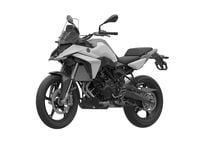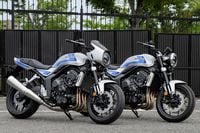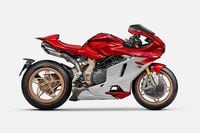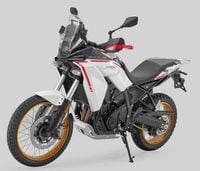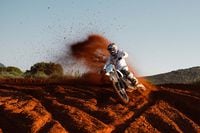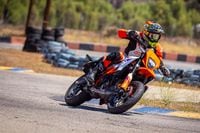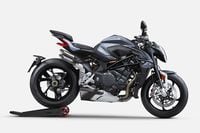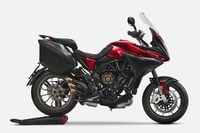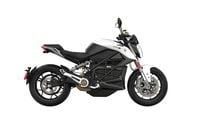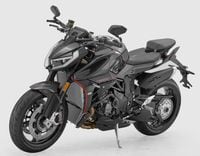First Ride Naked bikes have never sold well in the U.S. Although European brand loyalists surely beg to differ, the actual number of naked bikes sold here is miniscule compared to other categories, and especially tiny compared to the numbers sold in Europe. Thus it’s easy to see why most manufacturers’ American lineups are devoid of any fairing-less bikes that used to be the standard in the ‘70s. The attempts in the recent past-especially by the Japanese factories-have received a tepid response at best from American consumers.
So it was easy to wonder at first why Kawasaki was even bothering with the new Z1000. While the previous two generations of Z1000 were interesting bikes in their own right, both editions didn't exactly ring up major sales in the USA. But there was a distinct enthusiasm for the new Z1000 among the Kawasaki personnel that went well beyond the usual company loyalty or sales pitches. "We were seriously considering just letting you ride the bikes first and skipping the tech presentation until afterward," admitted Kawasaki senior media relations manager Jeff Herzog at the 2010 Kawasaki Z1000 press launch in Cambria, California, "because we wanted to see your reaction after riding it. Riding the bike tells you more about it than any technical presentation ever could."
A Clean Slate Actually, the new Z1000 almost never made it to American shores. After lackluster sales with two editions of the bike (the '07 model only made it to the '08 lineup before being axed a year later), Kawasaki Motor Corp USA product planning reps said "no thanks" when parent company Kawasaki Heavy Industries offered the '10 version Z1000. KHI management was persistent however, and asked the KMC reps to consider riding the bike before making a final judgment. Ironically, it was a day spent riding the bike at Kawasaki's world-class Autopolis racing circuit in Japan that convinced the American KMC reps that perhaps the KHI officials might be on to something. "We couldn't believe how much fun to ride the Z1000 really was," recalled Kawasaki product manager Karl Edmondson, "and it's quickly become the favorite bike of everyone who's ridden it at KMC."
How could a bike that was merely a footnote in past years suddenly become the greatest thing since the color green to Kawasaki personnel? After all, the new Z1000 still bears more than a faint resemblance to the previous generation model.
The key is that the Z1000 is a new design literally from the ground up. For instance, instead of all-too-common model integration that is rampant among manufacturers these days-say, enlarging the current ZX-10R powerplant and taking the well-worn adspeak path of "retuning it for midrange response" (read: neutering it completely), or simply boring out the last generation's ZX-9R-based engine-the 1043cc mill is an all-new design built specifically for the new Z1000. Sporting bore/stroke measurements of 77.0 x 56.0mm, the engine's longer-stroke configuration (compared to the previous Z1000's 77.2 x 50.9mm, or the current ZX-10R's 76 x 55mm) signals that its potential is geared more toward midrange power, the kind naked-bike riders use the most. Adding to the torque potential is the compression ratio jumping from 11.2:1 to 11.8:1.
In order to keep the longer stroke from contributing to excessive engine height, the crankshaft was lowered 17.3mm and moved forward 6.2mm, resulting in a crankshaft/mainshaft/countershaft lineup that is angled 5 degrees downward instead of the level plane of the previous engine. A secondary balancer was fitted in front to quell excess vibes from the inline-four layout (as well as allow an extra motor mount for a more rigid chassis and improved handling). Even with the larger displacement and secondary balancer, the new engine is about the same size overall as its predecessor.
Feeding the new engine are 38mm Keihin throttle bodies (up from 36mm) with oval sub-throttle cross-sections. The airbox features a new fresh air (not ram-air) system utilizing external scoops in the bodywork to feed air into a central intake at the front. A special resonator chamber at the entrance to the airbox enhances intake noise. Spent gases are fed into a 4-in-2-into-2 exhaust, with the now-common under-engine pre-chamber permitting each twin-exit muffler to reduce volume by 0.4 gallons, in turn allowing each muffler to drop 1.5 pounds. A new catalytic converter setup uses a single "pre-catalyzer" to "light off" quicker so that warm-up emissions are reduced, with two 300-cell/square inch split-type catalyzes downstream to further clean up the exhaust.
The other major feature with the new Kawasaki is its all-new aluminum chassis that is specific to the Z1000 as well. In a world of easy-to-build steel backbone or mildly-modified supersport frames normally seen in the cost-conscious naked bike market, the Z1000's well-designed, sportbike-style chassis is a nice switch that shows how far production techniques have come. Made from five precision cast pieces to reduce the number of welds, the structure not only is 8.8 pounds lighter but 30 percent more rigid torsionally as well. The rear sub-frame is now die-cast aluminum, with a removable three-piece construction that is lighter, lower, and narrower to ease planting your feet on the ground at a stop.
Suspension upgrades include a new 41mm inverted fork that now features adjustable compression damping in addition to rebound and spring preload adjustment. The rear shock is now mounted horizontally, with the linkage mounted on top of the swingarm instead of below; the setup not only keeps the shock away from exhaust heat and vastly eases shock adjustments, but also allows a lower seat height because the top shock mount is no longer in the way. The non-reservoir-equipped shock is adjustable for rebound and spring preload.
Brakes and other rolling stock weren't left out of the new and improved department either. The same superb radial-mount four-piston calipers found on the current ZX-10R clamp on 300mm petal discs, while the rear 250mm petal disc is grabbed by a single-piston caliper now mounted below the axle instead of above as before. Five-spoke cast aluminum wheels (6.00 x 17-inch rear, 3.50 x 17-inch front) now sport a "two-tone" look, with a polished outer rim and machined cutaway on each spoke contrasted against the usual black background; OEM-spec Dunlop D210 Sportmax rubber (the tires are only available through dealers, not off-the-shelf through Dunlop USA) is mounted on each end.
The end result is a new Z1000 pumping out a claimed 138 crankshaft horsepower at 9600 rpm (versus the previous 125 horsepower at 10,000 rpm) and 81.1 ft-lb of torque at 7800 rpm (against the old 72.7 ft-lb at 8200 rpm), while scaling in 22 pounds lighter at 481 pounds full of fuel ready to ride.
Try It, You'll Like It First thing you notice when swinging a leg over the new Z1000 is how narrow its midsection is. The front portion of the seat is slim enough to make the listed 32.1-inch seat height seem lower since your legs aren't forced to splay outward, yet scooting back a tad showed it's wide and supportive enough to keep our backsides from crying uncle after a two-hour saddle stint. Ergos struck a nice balance between sport serious and standard comfy, with the aluminum handlebar offering just enough rise to keep your wrists and back from requiring a massage therapist, and the grippy footpegs (lifted straight from the ZX-10R) positioned with just enough legroom and backward set to prevent hard parts from dragging on the pavement too easily, yet keep your knees and ankles from seizing.
One of the aspects that we've always found bothersome in previous naked bikes from the Big Four was that the edges were always rounded off far too much, especially compared to the European offerings. No matter what bike/engine they were descended from, there was always a little too much softness for our liking-both with the engine and the chassis.
With the new Z1000 powerplant's longer stroke/bigger displacement configuration, the overly soft label is no longer an issue. Here is a Japanese inline-four naked bike that finally "gets it"; snap the throttle open at 4000 rpm, and you get some instant pull that simply doesn't exist on other inline-four nakeds. The Kawasaki continues to gain noticeable spunk at 7000 rpm, generating the type of arm-pulling acceleration that the "retuned for midrange power" engines of the past nakeds should have had from the beginning. And the party doesn't taper off until 1000 rpm short of the new mill's 11,000-rpm redline, meaning you've got a wide swath of power to play with on the Z1000 (which is a good thing, as trying to read the tiny bar graph tachometer on the four-position-adjustable-tilt LCD dashboard at a glance is difficult at best).
A feature that we'd guess is a by-product of the hard-to-read tachometer would be the Z1000's "soft" rev-limiter that doesn't abruptly call a halt to the festivities and possibly upset handling midcorner. On the other end of the spectrum, off-idle throttle response is smooth as silk, another good thing as unfortunately Mother Nature decided to dump on us during the press launch in Cambria and check our wet weather pavement skills during the latter part of the ride.
That wet weather also meant we weren't able to really put the new suspension and chassis to a reasonable test. What we could glean from the few dry pavement twisty sections we encountered was a much lighter and neutral-steering Z1000 than past editions. Initial turn-in required little effort yet wasn't at all flighty-a necessary component with the combination of powerful engine and upright handlebars with plenty of leverage. In fact, overall stability over most of the sections we ran through on the press launch (which were plenty rough in many spots) was excellent, all remarkable traits for an upright-ergonomics bike with a 24.5-degree rake angle and no steering damper.
The suspension was tuned on the firm side in anticipation of the hard riding Kawasaki personnel were intending to lead us on before the rain intruded, so we weren't really able to discern much on its capabilities. The few sections we were able to hit at a decent speed showed good chassis and wheel control, but a more realistic test will have to wait until we get our hands on a test unit. Even with the firm settings, the suspension showed decent compliance at slower speeds, although sharper bumps still tended to upset the chassis a bit.
Braking power from the new front brake setup was amply powerful with plenty of feel, offering good response for more experienced riders without being too fierce for the less-skilled. Even traction from the OEM-spec Dunlop D210 Sportmax rubber was decent in both dry and wet conditions, with less of the harsh ride that we encountered with the same Dunlops on the '09 Yamaha R1 (although much can change between the OEM-spec tires of the same brand and model).
Probably best of all, however, is that the new Z1000 will retail for $10,499. In a time of half-faired standards that don't offer near the performance with cheaper componentry, the Z1000 looks like a bargain.
Not The Same Old Thing Kawasaki USA is kind of going out on a limb here with the new Z1000, if past naked bike sales are anything to go by. But the 2010 version is vastly unlike any of its predecessors from Kawasaki or any other Japanese manufacturer when it comes to performance. The biggest obstacle Kawasaki faces with the new Z1000 is convincing the American motorcycling public to look beyond the past performance history of naked bikes from the Japanese manufacturers (and any trivial mutterings about the new Z1000's Euro-intentioned styling), and discover just how much fun it is to actually ride. To address this, Kawasaki will be offering demo rides at various select events across the country; we highly recommend that you grab the opportunity to take one for a spin. Even our brief exposure was enough to show us that the new Kawasaki Z1000 definitely deserves a place in Kawasaki's American lineup for '10.
2010 Kawasaki Z1000 MSRP: $10,499 Engine Type: Liquid-cooled, DOHC, four-stroke inline-four, four valves/cyl. Displacement: 1043cc Bore x stroke: 77.0 x 56.0mm Compression ratio: 11.8:1 Induction: Keihin EFI, 38mm throttle bodies w/oval sub-throttle assemblies, single injector/cyl.
Chassis Front tire: Dunlop D210F Sportmax, 120/70ZR-17 Rear tire: Dunlop D210 Sportmax, 190/50ZR-17 Rake/trail: 24.5 deg./4.1 in. (104mm) Wheelbase: 56.7 in. (1440mm) Fuel capacity: 4.0 gal. (15L) Claimed wet weight: 481 lb. (218kg) full fuel, ready to ride










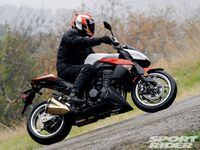
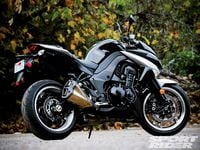
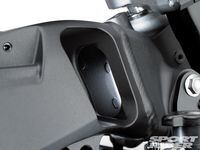
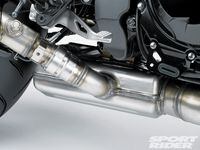
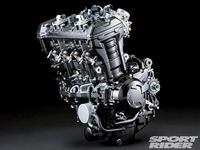
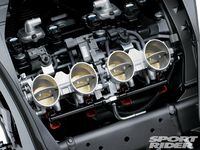
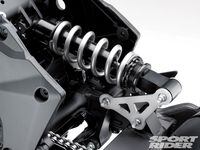
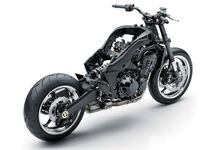
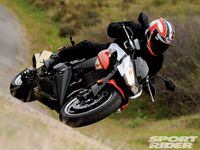
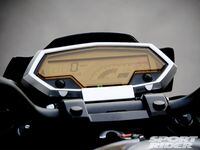
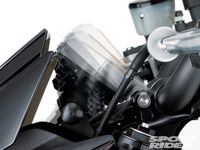
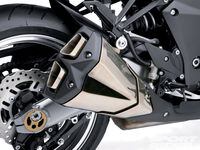
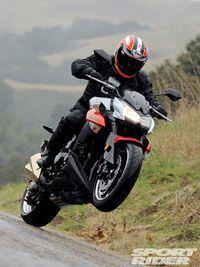
/cloudfront-us-east-1.images.arcpublishing.com/octane/6JPU4U2H7GOYZH2ZETYQBFLR2Q.jpg)
/cloudfront-us-east-1.images.arcpublishing.com/octane/CXNPUJDPPBCVHIRI5H7UOCX5HY.jpg)
/cloudfront-us-east-1.images.arcpublishing.com/octane/RZ5QNVGN4ZDRHJIKTPHGDX3HKA.jpg)
/cloudfront-us-east-1.images.arcpublishing.com/octane/ZGBASNGFXVBGXAQGDM6EWLNFXA.jpg)
/cloudfront-us-east-1.images.arcpublishing.com/octane/54BEFUE3XBDCTCAYUYQNZGAJV4.jpg)
/cloudfront-us-east-1.images.arcpublishing.com/octane/5XF2ZKSOR5G7TO23KSYT4JADTU.jpg)
/cloudfront-us-east-1.images.arcpublishing.com/octane/VHUK3FH6WFHLTHN7CKCATU36LM.jpg)
/cloudfront-us-east-1.images.arcpublishing.com/octane/HC4P3CYOXFF3NGXCQTGORFRYNY.jpg)
/cloudfront-us-east-1.images.arcpublishing.com/octane/ZNANUJGGKVBIFH3VRZ32BYC454.jpg)
/cloudfront-us-east-1.images.arcpublishing.com/octane/JACAJ4MPKJBTDBOZRTHXZAKLTA.jpg)
/cloudfront-us-east-1.images.arcpublishing.com/octane/7L3YWQXRBRECXMWQ6NBVAHU2EY.jpg)
/cloudfront-us-east-1.images.arcpublishing.com/octane/BPD5CKH5IFGDLG67Y24UMOXXGA.jpg)
/cloudfront-us-east-1.images.arcpublishing.com/octane/CHQ32B6TVBEPVFNPERY3AB2H3M.jpg)
